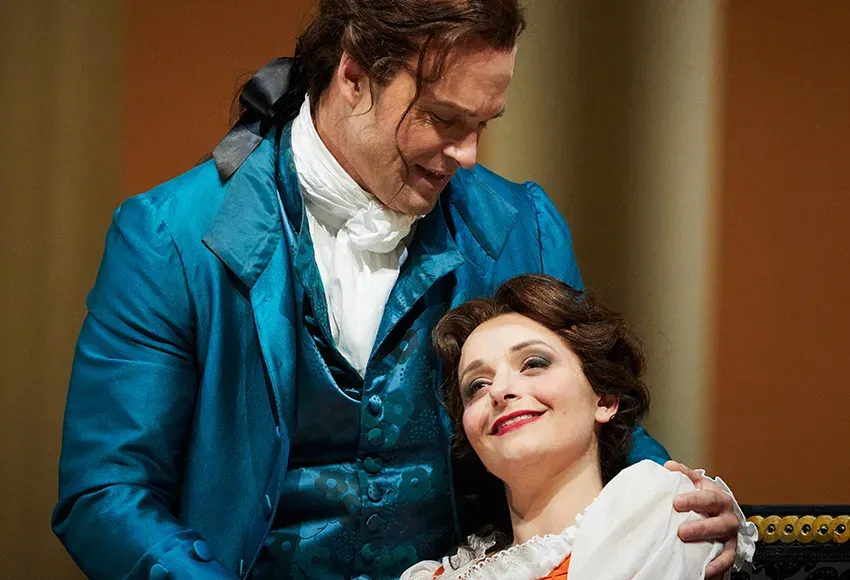THE MARRIAGE OF FIGARO
by Wolfgang Amadeus Mozart (music) and Lorenzo Da Ponte (libretto)
McCaw Hall
Opening weekend, May 7 and 8 (onstage through May 22)
I've never met a Marriage of Figaro I didn't like. A profusion of gorgeous melodies and harmonies, a libretto that tempers hilarity with pathos, a set of memorable characters, a revolutionary social message of equality – what's not to like? Even a mediocre production can lift my spirit for days, and the one currently running at Seattle Opera is far from mediocre. This production of the lovable opera represents the Mozart-Da Ponte collaboration at its finest.
Women conductors are still a rarity, so the opening-weekend audiences gave Maestra Alevtina Ioffe a rousing ovation before she'd even lifted her baton. From the first notes of the overture, she established the opera's bouncy, sprightly feeling.

The curtain rose to reveal what stage director Peter Kazaras calls "a trompe l'oeil set, in which nothing is what it appears to be." The chessboard floor confused the audience's perspective, the pale blue painted walls simulated folds of drapery, the many doors (essential for the bedroom farce component of the story) disappeared into the walls. Columns set at uneven distances added to the spatial illusion, and in the final scene, trees moved about the stage.
The late Benoît Dugardyn designed the set for Glimmerglass Opera, and Myung Hee Cho originally designed the sumptuous, colorful costumes for the Washington National Opera. In post-performance remarks, Seattle Opera General Director Christina Scheppelmann mentioned that parts of the set had been damaged in shipping and had to be restored upon arrival; Kazaras added that supply-chain problems had made it extremely difficult for the costume shop to find suitable fabrics – so extra credit to Seattle Opera for producing such a fine result in difficult times.
The first characters we meet are Figaro (valet to the Count Almaviva) and Susanna (chambermaid to the Countess), who are preparing to be married later in the day. Their playful, bantering tone immediately endears them to the audience, now primed to cheer them on through the trials of what the Count later calls "a day from hell."
On opening weekend, the singers playing Susanna (sopranos Soroya Mafi and Anya Matanovi? in alternating performances) and Figaro (bass-baritones Ryan McKinny and Michael Sumuel) were all excellent vocally and dramatically. Both Mafi and Matanovi? conveyed Susanna's sharp intelligence and had the stamina to sing lengthy recitatives and ensemble numbers throughout the opera, and then in the final scene, to produce the lovely, lyrical aria "Deh vieni" with a fresh, pure tone. Mafi's performance throughout was simply fabulous. McKinny's Figaro was more lithe and athletic than Sumuel's, but both men did a great job with the role.

The two baritones playing the philandering Count differed in their interpretation of the character, but both were skillful and interesting performers. On opening night, Norman Garrett showed the insecurity underlying the Count's arrogance; the next afternoon, Joshua Hopkins emphasized the character's vanity. Hopkins' rendition of the rage aria "Hai gia vinta la causa" was particularly impressive.
Marjukka Tepponen and Helena Dix, the two sopranos playing the heartbroken Countess, both excelled in the ensemble scenes, but neither had the rich, creamy voice required for the arias "Porgi amor" and "Dove sono."

Mezzo-sopranos Olga Syniakova and Emily Fons both conveyed the awkward sweetness of the hormone-crazed boy Cherubino, but opening-night jitters got the best of Syniakova during the speedy aria "Non so più," in which the singer is supposed to convey breathlessness without actually becoming breathless.

In the broadly comic roles of Marcellina, Doctor Bartolo, and Don Basilio, mezzo-soprano Margaret Gawrysiak, bass Kevin Burdette, and tenor Martin Bakari, respectively, were absolutely marvelous.

Under Maestra Ioffe's direction, the orchestra (composed of members of the Seattle Symphony Orchestra) couldn't have sounded better. Cellist Efe Baltacigil, harpsichordist Philip A. Kelsey, and all members of the woodwind section deserve special praise. In some of the fast-paced sections of the score, however, Ioffe's tempo was so fast that the singers just couldn't keep up. This was a problem especially in scenes involving the chorus, and especially during the Sunday matinee of opening weekend. I assume that the tempo will become more moderate in future performances.
The production benefited from Kazaras' intimate knowledge of opera and his long association with Seattle Opera. The pacing of the comic scenes was brilliant, with the action teetering on the verge of chaos and the stage gradually filling with characters and complications. Kazaras made sure that every character, including every member of the chorus, was differentiated from the others. For example, when peasants from the Count's estate file before him two by two to present flowers, we see a furious woman who must have been a victim of his assault, a woman who flirts with him and is pulled away by her husband, and a very pregnant woman accompanied by a very angry man. These directorial touches make the difference between a mediocre production and an exceptional one.
Also, Jonathan Dean's superb English captions do full justice to the text of the extraordinary libretto.
Perhaps the central theme of The Marriage of Figaro is that of forgiveness. Repeatedly, characters ask forgiveness and are denied. The motto inscribed on a beam over the stage is Perdono non merta chi agli altri non da: "Forgiveness is not deserved by one who doesn't grant it to others." At the very end of the opera, with perhaps the most beautiful music Mozart ever composed, the Count requests forgiveness, and the Countess grants it. Whether deserved or not, this moment of forgiveness is sublime.
One of the greatest operas ever written, and two wonderful casts – how can you go wrong?
For more information and to order tickets, go to https://www.seattleopera.org/.


